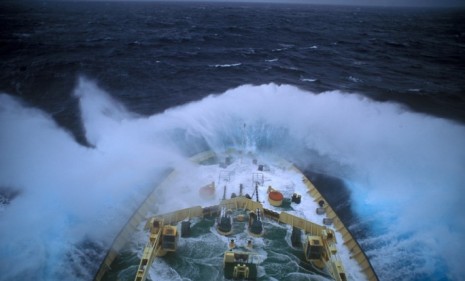The last word: Terrors of the sea
Are "rogue waves" responsible for the disappearance of dozens of ships every year?

THE CLOCK READ midnight when the 100-foot wave hit the ship, rising from the North Atlantic out of the darkness. Among the ocean’s terrors, a wave this size was the most feared and the least understood, more myth than reality—or so people had thought. This giant was certainly real. As the RRS Discovery plunged down into the wave’s deep trough, it heeled 28 degrees to port, rolled 30 degrees back to starboard, then recovered to face the incoming seas. What chance did they have, the 47 scientists and crew aboard this research cruise gone horribly wrong? A series of storms had trapped them 250 miles off the coast of Northern Ireland in the black void east of Rockall, a volcanic island that is nicknamed Waveland for the nastiness of its surrounding waters. More than a thousand wrecked ships lay on the seafloor below.
Captain Keith Avery steered his vessel directly into the onslaught, just as he’d been doing for five days. While weather like this was common in the cranky North Atlantic, these waves were unlike anything he’d encountered in 30 years of seafaring. And worse, they kept rearing up from different directions. Avery knew their only hope was to remain where they were, with their bow pointed into the waves. Turning around was too risky; if one of these giants caught Discovery broadside, there would be long odds on survival. A breaking 100-foot wave packs 100 tons of force per square meter and can tear a ship in half.
Below deck, the scientists huddled in their cabins nursing black eyes and broken ribs. Ten days earlier, in late January 2000, they had left port in Southampton, England, on what they had hoped would be a typical three-week trip to Iceland and back. Along the way they’d stop and sample the water for salinity, temperature, oxygen and other nutrients. From these tests the team would draw a picture of what was happening out there, how the ocean’s basic characteristics were shifting, and why. These are not small questions on a planet that is 71 percent covered in salt water. As the Earth’s climate changes—as the winds increase, as the oceans heat up—what does all this mean for us? Trouble, most likely, and this team was in the business of finding out how much. It was deeply frustrating for them to be lashed to their bunks rather than out on the deck working.
The Week
Escape your echo chamber. Get the facts behind the news, plus analysis from multiple perspectives.

Sign up for The Week's Free Newsletters
From our morning news briefing to a weekly Good News Newsletter, get the best of The Week delivered directly to your inbox.
From our morning news briefing to a weekly Good News Newsletter, get the best of The Week delivered directly to your inbox.
The trip was far from a loss, however. During the endless trains of massive waves, Discovery itself was collecting data that would lead to a chilling revelation. The ship was ringed with instruments; everything that happened out there was being precisely measured. Months later, long after Avery had returned everyone safely to the Southampton docks, Penny Holliday, one of the expedition’s two chief scientists, began to analyze these figures and would discover that the waves they had experienced were the largest ever scientifically recorded in the open ocean. The significant wave height, an average of the largest 33 percent of the waves, was 61 feet, with frequent spikes far beyond that. At the same time, none of the state-of-the-art weather forecasts and wave models—the information upon which all ships, oil rigs, fisheries, and passenger boats rely—had predicted these behemoths. In other words, under this particular set of weather conditions, waves this size should not have existed. And yet they did.
HISTORY IS FULL of eyewitness accounts of giant waves, monsters in the 100-foot range and beyond, but until very recently scientists dismissed them. The problem was this: According to the basic physics of ocean waves, the conditions that would produce a 100-footer were so far beyond rare as to virtually never happen. Anyone who claimed to have seen one, therefore, was engaging in nautical tall tales or outright lies.
Even so, it was difficult to discount a report from the polar hero Ernest Shackleton, hardly the type for hysterical exaggeration. During his crossing from Antarctica to South Georgia Island in April 1916, Shackleton recorded an encounter with a wave far larger than any he had seen in 26 years of experience on the ocean. “It was a mighty upheaval of the ocean,” he wrote. When the wave hit his ship, Shackleton and his crew were “flung forward like a cork.” Fast bailing and major luck were all that saved them from capsizing. “Earnestly we hoped that never again would we encounter such a wave.”
The men on the 850-foot cargo ship München would have seconded that, if any of them had survived their rendezvous with a similar wave on Dec. 12, 1978. Considered unsinkable, the München was a cutting-edge craft, the flagship of the German Merchant Navy. At 3:25 a.m., fragments of a Morse code Mayday, emanating from 450 miles north of the Azores, signaled that the vessel had suffered grave damage from a wave. But even after 110 ships and 13 aircraft were deployed—the most comprehensive search in the history of shipping—the ship and its 27 crew were never seen again. A haunting clue was left behind: Searchers found one of the München’s lifeboats, usually stowed 65 feet above the water, floating empty. Its twisted metal fittings indicated that it had been torn away. “Something extraordinary” had destroyed the ship, concluded the official report.
A free daily email with the biggest news stories of the day – and the best features from TheWeek.com
The München’s disappearance points to the main problem with proving the existence of a giant wave: If you run into that kind of nightmare, it’s likely to be your last. The force of waves is hard to overstate. An 18-inch wave can topple a wall built to withstand 125-mph winds, for instance, and 5-foot-tall surf regularly kills people caught in the wrong places. The number of people who’ve witnessed a 100-foot wave and made it back home to describe the experience is very small.
Then, in 1995, something happened that no one could ignore. On Jan. 1 that year, the North Sea was feisty due to a pair of storms, a brutish one crawling northward and a smaller one moving southward to meet it. Statoil’s Draupner oil-drilling platform sat somewhere between them, about 100 miles off the tip of Norway. For the crew who lived on the rig it was a New Year’s Day of 38-foot seas rolling by, as measured by the laser wave recorder on the platform’s underside.
Unpleasant, perhaps, but not especially dramatic—until 3 p.m., when an 85-foot wave careened over the horizon and walloped the rig at 45 mph. While the Draupner sustained only moderate damage, the proof was there. This wasn’t a case of laser malfunction or too many aquavit toasts the night before. It was the first confirmed measurement of a freak wave, more than twice as tall and steep as its neighbors, a teetering maniac ripping across the North Sea.
They were out there all right. You could call them whatever you wanted—rogues, freaks, giants—but the bottom line was that no one had accounted for them. The engineers who’d built the Draupner rig had calculated that once every 10,000 years the North Sea might throw them a 64-foot curveball in 38-foot seas. Eighty-five-foot waves were not part of the equation. But the rules had changed. Now scientists had a set of numbers that pointed to an unsettling truth: Some of these waves make their own rules. Suddenly the emphasis shifted from explaining why giant waves couldn’t simply leap out of the ocean to figuring out how it was that they did.
This was a matter of much brow sweat for the oil industry, which would prefer that its multimillion-dollar rigs not be swept away. It had happened before. In 1982 the Ocean Ranger, a 337-foot-high oil platform located 170 miles off the coast of Newfoundland, was struck by an outsize wave in heavy weather. We’ll never know how big the wave was exactly, for there were no survivors. Built to withstand 110-foot seas, the Ocean Ranger had capsized and sank close to instantly, killing all 84 people on board.
In the nautical world things were even more troubling. Across the global seas ships were meeting these waves, from megaton vessels like the München down to recreational sailboats. At best, the encounters resulted in damage; at worst, the boats vanished. “Two large ships sink every week on average [worldwide], but the cause is never studied to the same detail as an air crash. It simply gets put down to ‘bad weather,’” said Dr. Wolfgang Rosenthal, senior scientist for the MaxWave Project, a consortium of European scientists that convened in 2000 to investigate the disappearing ships.
While Rosenthal’s numbers may be high, his point is well taken. Exact statistics of ships scuttled by giant waves are impossible to come by, but it is clear that every year, on average, more than two dozen large ships sink or otherwise go missing, taking their crews with them. When I first read about the missing ships, I was astonished. In the high-tech marine world of radar, GPS, and satellite surveillance, how could hundreds of enormous vessels just get swallowed up by the sea? Imagine the headlines if even a single 747 slipped off the map with all its passengers and was never heard from again. After the Draupner incident, it became undeniable: No one had a clue how waves behaved in the most extreme forms.
A WAVE MIGHT seem to be a simple thing, but in fact a wave of any kind is the most complicated form in nature. Paradoxically, a wave is both an object and a motion. When wave energy moves through water, the water itself doesn’t actually go anywhere. The wave energy does. It’s like cracking a whip.
In order to exist, waves require a disturbing force and a restoring force. In the ocean that disturbing force is usually, but not always, the wind. (Earthquakes, underwater landslides, and the gravitational pull of the sun and moon can also play this role.) The restoring force is usually, but not always, gravity. And all of this goes to explain why, if you’re serious about trying to pin down a wave, you turn to equations rather than words.
But math fails even the experts, because waves in nature do all sorts of bizarre stuff. When Penny Holliday finally got around to studying her data from Discovery’s stormy February 2000 trip, she and a colleague at the National Oceanographic Center in Southampton concluded that most of the higher-than-expected waves the ship encountered were created by an effect known as “resonance.” Resonance is an aspect of nonlinearity that is endlessly complex when scrawled across a whiteboard, but kindergarten-simple when explained by the analogy of a kid pumping his legs on a swing, dramatically boosting his height on each pass. Energy is continually being added to the system, more and more and more, in erratic bursts. Likewise in the North Atlantic, wind energy surged into the waves until they grew to enormous proportions.
But the freak waves—the mutants that are three or four times taller than anything else in the surrounding seas? One of Holliday’s colleagues, Peter Challenor, admits that an explanation for those giants is a long way off. “We don’t have that random messy theory for nonlinear waves. At all,” he says. “People have been working actively on this for the past 50 years at least. We don’t even have the start of a theory.”
The ocean, it seems, doesn’t subscribe to the orderly explanations that we would like it to. Its depths still hold more secrets than anyone can count.
From The Wave: In Pursuit of the Rogues, Freaks, and Giants of the Ocean. ©2010 by Susan Casey. Published by arrangement with Doubleday, an imprint of The Knopf Doubleday Group, a division of Random House, Inc.
-
 6 gripping museum exhibitions to view this winter
6 gripping museum exhibitions to view this winterThe Week Recommends Discover the real Grandma Moses and Frida Kahlo
-
 Why do Republicans fear swing state immigration raids in North Carolina?
Why do Republicans fear swing state immigration raids in North Carolina?Today's Big Question Trump's aggressive enforcement sparks backlash worries
-
 ‘Every teacher is a literacy teacher’
‘Every teacher is a literacy teacher’Instant Opinion Opinion, comment and editorials of the day